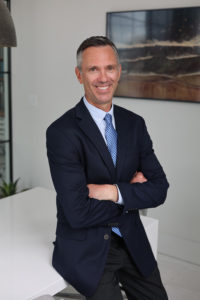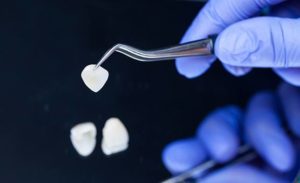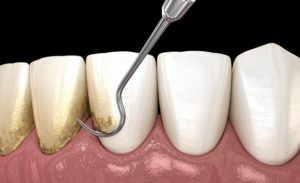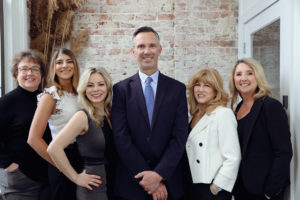J. Peter St. Clair, DMD Blog
IT’S A CHOICE – PART 2
April 16, 2024
 Last week I introduced a couple who had been seeing the same dentist for 30 years and were finally forced to make a change due to the dentist’s retirement. They visited a “new” dentist and were turned off because the dentist recommended significant treatment. Then they consulted with another dentist, who spent more time with them to discuss their specific situations and goals. However, they still missed their “old” dentist.
Last week I introduced a couple who had been seeing the same dentist for 30 years and were finally forced to make a change due to the dentist’s retirement. They visited a “new” dentist and were turned off because the dentist recommended significant treatment. Then they consulted with another dentist, who spent more time with them to discuss their specific situations and goals. However, they still missed their “old” dentist.
The couple loved their “old” dentist because she was someone they could relate to. The dentist kept things simple, and they liked simple. If they had a broken tooth, the dentist patched it up and they were on their way. They never talked about the future. They may have lost some teeth over the years, but the dentist never discussed “needing” a lot of dental work.
The first “new” dentist was a nice person. In fact, they knew the dentist outside the office before they became patients. The problem was poor communication and inability to relate to the patient’s specific needs. This dentist looked in both their mouths and said they each “needed’ 8 crowns. It didn’t make sense to them. It seemed too complicated, expensive and unnecessary.
The second “new” dentist took a different approach and spent time with the couple discussing their current situation and future objectives. They both wanted to keep their teeth but still had trouble coming to grips with the fact that they “needed” significant dental work to accomplish their objective. Why couldn’t they continue on the same simple path they had with their original dentist?
Dentists are sometimes more interested in what they are saying than patients are. It is important to remember that the teeth are attached to a person; and that person has their own story that goes along with their teeth.
People put different values on different things. Whether we sell cars, trips, hairstyles or teeth, the objective of the “seller” is to make the prospective “buyer” aware of what they have and all the possibilities that are available to them. It is always the consumer’s decision. While there is a health component to dentistry, you can compare any other aspect of selling the other commodity examples to teeth. Things that come to mind: comfort, looks, self-esteem, and functioning in life.
To “buy” anything, people have to be ready. What makes someone ready? They are ready when they feel the need to act. In the absence of readiness, over-education by the “seller” often feels like sales pressure to the buyer. I’m sure you have experienced this if you have ever been to a car dealership.
I love analogies. I especially love car analogies as they relate to dentistry. Cars are easy because most of us rely on them every day, just like our teeth. Some of us like simple cars, while others like fancier cars. Some take better care of their cars and they last longer. Others abuse their cars and they need more repairs. One thing is certain; maintenance is the key to long-term success of the car.
Raising awareness is a difficult task for anyone promoting their product or service. Acting on something is only accomplished when value is realized. Some end up seeing the value in their life and others do not.
Dr. St. Clair maintains a private dental practice in Rowley dedicated to health-centered family dentistry. He has a special interest in treating snoring, sleep apnea and TMJ problems. If there are certain topics you would like to see written about or questions you have please email them to him at jpstclair@stclairdmd.com
IT’S A CHOICE – PART 1
April 8, 2024
People often ask me how I have time to write columns, and how I’ve come up with topics for as long as The Town Common has been around. If you have read my columns over the years, you’ll remember I have discussed that time was one of the barriers keeping people from getting the dental care they need. Time is an excuse and I use it as an excuse all the time. However, we always make time for things that are important to us.
The topics I come up with have been an evolution. I try to keep it interesting. Of course, many of the things that I find interesting in dentistry would bore others. While some of my columns may bore you to tears, hopefully there are others that you can relate to, or stimulate thoughts or questions.
Let’s talk today about a common scenario seen in all dental offices. New patients, husband and wife in their 60’s, are “forced” to make a dental provider change. I say “forced” because regardless of our situation, we always have a choice in our providers.
This couple had been seeing the same dentist for 30 years. Despite the fact that they moved 20 miles from the dentist 10 years ago, they continued to make the drive to the office. They were dedicated and they loved their dentist. Then one day the dentist retired and they decided it was time to choose someone closer to where they lived.
Both went to their new office for hygiene appointments and then discussed their experience. They both felt the office staff was less friendly than their previous office. Of course, they knew that “old” office and loved everyone there. They were still willing to give it a chance, until they met the dentist. The dentist seemed like a nice person but took a quick look and said the same thing to both husband and wife – You NEED 8 crowns.
How could this be, they thought? They had been going to the same office for 30 years, neither ever had a crown, and when something broke, their favorite dentist would “patch” them up. They were completely turned off. They were “forced” again to make a change.
This time they wanted to meet the dentist first and see what the dentist had to say before they committed. They set up a 30-minute appointment. At that appointment, the “new” dentist examined their x-rays and took photographs of their teeth. They had an in-depth conversation about the condition of their dental health. They were asked what their short-term and long-term objectives were. The word “crown” was never mentioned…..until one of them asked the dentist.
The dentist discussed advantages and disadvantages of different kinds of treatment. Since the patient’s long-term objective was to have teeth forever, they discussed options for treatment, prioritization and sequencing, as well as financial options. Although they were not ready to dive into treatment, they left the office with a much better understanding of where they stood and appreciated the time that was taken to explain their specific situations.
Every person, every patient, every dentist, is different. This couple experienced three different practice styles. They could relate to Dentist #1 – their “old” dentist. Dentist #2 lacked communication skills, therefore the relationship failed. Dentist #3 took the time to learn about their specific needs and goals. They didn’t feel sales pressure but are still overwhelmed by their apparent “needs.”
To be continued……
Dr. St. Clair maintains a private dental practice in Rowley dedicated to health-centered family dentistry. He has a special interest in treating snoring, sleep apnea and TMJ problems. If there are certain topics you would like to see written about or questions you have please email them to him at jpstclair@stclairdmd.com
SNORING IS NOT NORMAL
April 1, 2024
 It is not uncommon for me to get a strange look when I ask a patient about snoring in the dental office. After an explanation about some of the reasons I include this on my medical history form, the patient will often say, “Well, I don’t snore but my spouse does. In fact, we sleep in separate bedrooms.”
It is not uncommon for me to get a strange look when I ask a patient about snoring in the dental office. After an explanation about some of the reasons I include this on my medical history form, the patient will often say, “Well, I don’t snore but my spouse does. In fact, we sleep in separate bedrooms.”
A better way to ask someone about snoring is to ask, “Have you been told you snore?” Snoring can be a huge nuisance to the bed partner and is actually very detrimental to both people. For those without a bed partner, snoring can be assessed with apps such as Snore Lab, which measures snoring levels throughout the night.
Snoring is a sign of a restricted airway, which means that there is a possible depletion of air getting into the lungs and thus the brain. You spend approximately one third of your life sleeping, which means if you live to 90 years old, you may have spent 30 years sleeping. Oxygen depletion during sleep has both short-term and long-term consequences. I have read multiple studies which suggest a reduction of oxygen to the body can take 6-10 years off of your life. Sleep is one of the most mysterious states of being – we don’t know a lot about what is going on during sleep without it being recorded. Wouldn’t you want to know if your body wasn’t being oxygenated properly?
A restricted airway can be caused by numerous different factors. Many times, it is developmental and starts early in life. As we age, this risk for developing a restricted airway increases with things like gaining weight, muscle tone laxity, and even sleep position. Snoring is a fluttering of soft tissue in the back of throat due to there not being enough space for air to pass through. Not only does snoring have the potential to affect your brain and the way you feel on a day-to-day basis, it also disturbs the sleep of the person sleeping next to you….and in some cases, people in other rooms.
Snoring does not mean you have sleep apnea (a serious disorder measured by a sleep test,) but is a significant risk factor. If you do have sleep apnea, you need to know this so that it can be treated and you can live a better quality of life. If you don’t have sleep apnea and just snore, this can also be treated, and you may be able to make it back into your own bedroom.
Aside from snoring, if you have any of the following: familial history of sleep apnea, history of daytime drowsiness, history of clenching/grinding, history of TMJ disorder, history of mood disorders/depression, witnessed apnea events (gasping at night), large tongue with ridges on the sides, tooth wear, high blood pressure, gastric reflux, large neck (Males >17 / Females>16) – you should discuss this with your physician and/or your dentist.
There are different ways to treat snoring and/or sleep apnea including positional therapy (sometimes a wedge pillow strapped to your back so you can’t roll onto your back), a CPAP device (positive air pressure through the nose to keep the airway open), or a dental device (to keep the jaw and tongue from falling back).
Just like exercising and good eating habits are good for the body, quality sleep vital to good health. Just because you get 7-8 hours of sleep doesn’t mean it is good sleep. Don’t hesitate to talk with your doctors about your sleep issues…..and encourage the loud person sleeping next to you to do the same.
Dr. St. Clair maintains a private dental practice in Rowley dedicated to health-centered family dentistry. He has a special interest in treating snoring, sleep apnea and TMJ problems. If there are certain topics you would like to see written about or questions you have please email them to him at jpstclair@stclairdmd.com
DENTISTRY IN THE NEWS – PART 2
March 25, 2024
 Last week I discussed some of the content that was presented in a recent U.S. News & World Report which featured seven pages of information on dentistry. This is a continuation of that.
Last week I discussed some of the content that was presented in a recent U.S. News & World Report which featured seven pages of information on dentistry. This is a continuation of that.
One of the columns in this section of the report entitled, “Guarding Kids’ First Choppers”, mentions that childhood tooth decay is “the most prevalent chronic disease in children”. This is true. According to the report, 28 percent of preschoolers have dental decay. There are many factors that contribute to dental decay, including poor dietary habits and insufficient oral hygiene. This increase is not only in preschoolers but right through high school.
However, the column goes on to say that “dental visits should begin no later than a child’s first birthday”. That might be a little early, but certainly can’t hurt. However, parents should closely inspect their children’s teeth. If there is anything that is seen that is not tooth-colored or doesn’t look right, the child should be seen by a dentist. Pediatric dentists are one option but many general family dentists are more than willing to see children. If there are issues that warrant a pediatric specialist, the child can be referred.
Having said that, there are many newer lines of thinking in regards to child development. Things such as tongue attachments (tongue tie) should be evaluated early, as this is often a relatively easy fix. Earlier orthodontic intervention, to aid in better dental development and airway health, is also a newer trend. These are things that need to be evaluated by someone who is qualified in that specific area, which is often an airway-minded pediatric dentist, general dentist and orthodontist.
Another column in the report entitled, “The Wisdom on Wisdom Teeth”, says “the latest data suggests that as many as 80 percent of people will develop problems with their wisdom teeth”. This is true. In most people, wisdom teeth either will not fit with all of the other teeth in the mouth or they erupt crowded. This may not cause a problem right away, but because they are difficult to clean, they either get decay or cause periodontal problems with the neighboring teeth. The current line of thinking is to remove these teeth between the ages of 16-18, or before the roots are fully developed. This generally makes for a much less traumatic surgery.
In the article entitled, “Taking the Cost Out of the Bite”, it is discussed what to do if you don’t have dental insurance. One of the suggestions is “to consider purchasing an individual dental policy”, and the other is to look for discount programs which “give members 10 to 60 percent off at certain providers”. This is tricky. If you don’t get dental insurance from your employer or are not covered under a spouse’s plan, you really have to look at the numbers and also at what you are entitled to with particular plans. If it seems too good to be true, it probably is.
The cost of purchasing your own indemnity dental insurance plan usually outweighs the benefits. Most, if not all dental insurance plans have annual maximums which average $1000 per year. You pay the premium to the insurance company, which might be $750 a year, but then you only get $1000 in benefits. It may make sense for families but usually not for individuals. As far as the “discount plans” the column refers to – this is a buyer beware. These plans force you to choose a dentist from a list, and this list is usually not very long. It is important to consider the quality of care, or at least the level of care you desire.
Dental health is important to overall health on many different levels. Make it a priority!
Dr. St. Clair maintains a private dental practice in Rowley dedicated to health-centered family dentistry. He has a special interest in treating snoring, sleep apnea and TMJ problems. If there are certain topics you would like to see written about or questions you have please email them to him at jpstclair@stclairdmd.com
DENTISTRY IN THE NEWS – PART 1
March 18, 2024
A recent U.S. News & World Report featured seven pages of information on dentistry. Although I was surprised that most of the information was accurate, as the media often skews the facts to make a point, there were a few things that I felt needed clarification.
The first article highlights the fact that 75% of adults have some form of periodontal disease. This is true. It also mentions many of the known facts with regards to gum disease and systemic health. One of those is that uncorrected gum problems can make it more difficult for diabetics to control their blood sugar, and in turn worsen their gum problems. This is also true.
With regards to brushing, the article states, “Scrubbing with fluoride toothpaste robs oral bacteria of sustenance.” This is true to some extent but the term “scrubbing” is not completely accurate. Proper brushing technique with either a very soft manual toothbrush or good electric toothbrush is a more accurate description. Also, fluoride, in and of itself, is not truly anti-bacterial. Although it is felt that its anti-cavity action is related mainly to effects on mineral phases of teeth and on the process of remineralization (strengthening enamel), research does show that fluoride also has important effects on the metabolism of bacteria in dental plaque. There are other ingredients in toothpastes with and without fluoride that are more anti-bacterial, but it is the removal of plaque manually that is most important, even without toothpaste.
With regard to electric toothbrushes, the article insinuates that “basic” and “cheap” ($7) models are as effective as more expensive models. This is false. Although you do not have to buy the most expensive model available, there is a huge difference in effectiveness between a $7 battery-operated toothbrush and a $70 wall-charged one.
The article states, “Only floss can reach below the gum-line.” This is not completely true. Proper toothbrush technique gets below the gum-line on two sides of the teeth. Floss is important for removing debris between teeth. A water pik is probably most effective for cleaning the non-brushable areas in the mouth.
For combating bad breath, the article’s first suggestion is to “brush your tongue.” Although it mentions the use of a tongue scraper, it only states the use of this device if your toothbrush makes you gag. The fact of the matter is that a tongue scraper is 100% more effective in removal of the nasty bacteria on your tongue. If the toothbrush makes you gag so will the tongue scraper. One trick is to scrape your tongue while you are exhaling.
An article in the report entitled, “21st-Century Dentistry” highlights the use of lasers in treating gum problems. The beginning of the column gets you revved-up to believe that this is the best thing since sliced bread, but the end of the article states differently. “It is unlikely to fully replace traditional gum surgery anytime soon. The laser therapy isn’t demonstrably superior to surgery, researchers recently reported in the Journal of Periodontology.”
To be continued…….
Dr. St. Clair maintains a private dental practice in Rowley dedicated to health-centered family dentistry. He has a special interest in treating snoring, sleep apnea and TMJ problems. If there are certain topics you would like to see written about or questions you have please email them to him at jpstclair@stclairdmd.com
INTEGRATED HEALTH CARE
March 11, 2024
 Dentistry is one of those things in life….as with most things…. that people view in different ways. Some are interested in their appearance, some are interested in their health, some both, and others none of the above. A major role of health care providers is to make patients aware of the possibilities to improve their quality of life. When our services are perceived as a commodity, expectations are often not achieved.
Dentistry is one of those things in life….as with most things…. that people view in different ways. Some are interested in their appearance, some are interested in their health, some both, and others none of the above. A major role of health care providers is to make patients aware of the possibilities to improve their quality of life. When our services are perceived as a commodity, expectations are often not achieved.
Dentists play a key role in screening patients for many disorders relative to nutrition and in providing appropriate referrals into the health care system. Although the importance of integrating diet and nutrition guidance into dental care has been advocated for decades by educators, it continues to be ignored except by a handful of prevention-oriented practitioners.
Many of the world’s most significant health problems are linked to poor dietary practices, including over-nutrition and under-nutrition. Nutrition plays a fundamental role in health, and dental professionals have the opportunity to be a critical link between discovery and wellness.
There is a great deal of evidence linking oral infections, including periodontal disease, nutrition and immunological response. We have clear evidence linking oral disease with adverse pregnancy outcomes, diabetes, cardiovascular disease and stroke. In addition, obesity, which is an epidemic facing our country, is significantly affecting the incidence of diabetes, cardiovascular disease and overall lifespan. We know there are direct connections between these problems and oral disease. What is the role of the dentist? Should the dentist just be a tooth fixer?
As the body of data linking systemic health conditions and oral infection grows, this expanded understanding will result in more profound discoveries. However, we know right know that the scientific bridge between oral disease and systemic health is often mediated by diet and nutrition.
The beneficiary of this profound evidence should be you, the dental patient. It should not only be the responsibility of the physician or specialized nutritionist to incorporate this information into practice; the dentist should be playing a key role.
For the most part, the dentist is the only one who examines the mouth. It used to be that the dentist only looked at the teeth and only fixed problems if they arose. Most dentists screen for periodontal, or gum, problems as well as oral cancer. The trend is to address these problems earlier than ever before. Identifying developmental issues related to facial growth during childhood, for example, is much more than prescribing orthodontics. Lives can be changed with early intervention.
People tend to have ingrained in their head that the dentist just looks at the teeth and treatment should be the same as 25 years ago. The fact of the matter is, things change and there are no two dentists who practice identically. Each individual’s philosophy of care comes from personal experience, review of literature and the type and amount of continuing education taken.
One thing we all hope is that our health care provider, dentist or physician, has our best interest in mind. There is room for improvement in the communication between all health care providers. As science continues and evidence grows, it is the responsibility of all health care providers to work towards a more integrated health care system.
Dr. St. Clair maintains a private dental practice in Rowley dedicated to health-centered family dentistry. He has a special interest in treating snoring, sleep apnea and TMJ problems. If there are certain topics you would like to see written about or questions you have please email them to him at jpstclair@stclairdmd.com
FULL-SPEED FORWARD
March 4, 2024
 I’m sure we all agree that keeping up with technology is not easy. From computers to cell phones to cars, and everything in between, changes take place at lightning speed. No matter what we buy, there is always something right around the corner, or already there, that is better.
I’m sure we all agree that keeping up with technology is not easy. From computers to cell phones to cars, and everything in between, changes take place at lightning speed. No matter what we buy, there is always something right around the corner, or already there, that is better.
I purchased a digital x-ray system back in January of 2008 to replace film and chemicals to develop. By June of the same year, the same company came out with a smaller, thinner sensor. This didn’t make mine obsolete, but my $10,000 investment made six months before could now be purchased for half the price. I thought I was “jumping in” at the right time.
As with most, if not all industries, technology is sweeping the dental field. We are digitizing everything. Offices that are not already “paperless” are moving in that direction. Automated systems for appointment confirmation via text or email, scheduling appointments, paying bills online, filling out online forms, and digital patient charts have been commonplace in dental offices for a while.
Digital radiology is transforming the way we treatment plan and deliver services such as dental implants. This 3-Dimensional technology allows accurate evaluation of biological structures to provide almost pinpoint placement of dental implants that may not have been able to be done using traditional methods. Notice I said “almost” pinpoint accuracy. It’s still not perfect, but it keeps getting better and better.
You may be aware that some dental offices can make crowns chairside without the use of gooey impression materials or the need of a dental laboratory. This technology has been around for over 25 years. The first generation of this technology was pretty cool back in the day, but delivered less than stellar results. Today, it is safe to say, this technology has greatly improved, continues to get better, and is not going away.
While the technology has gotten significantly better, there are still limitations. Currently, this technology uses a reduction method to fabricate restorations. This means that the restoration is milled from a solid block of material. The material choices are somewhat limited but getting better. What’s next? Maybe 3-D printing of whatever material you would like to use.
I read an article recently about 3-D printing technology where the CEO of this particular company working on dental applications said, “If 3D printing hopes to break out of the prototyping niche it has been trapped in for decades, we need to find a disruptive technology that attacks the problem from a fresh perspective.” I think this technology will be a game-changer.
I have always struggled with when to “jump-in” with certain technologies. It’s not an easy decision. The high cost, the learning curve, and knowing there is always something better right around the corner have been the barriers for me. The more I read about what is on the horizon, the more I want to wait for the “next best thing.”
Dentistry is moving fast forward in technological advances. However, two things come to mind about technology and dentistry. The first, is to keep in mind that sometimes the best option may be an older model. For example, gold is still used in dentistry, and definitely has a place in certain circumstances. The second thing, is that someone has to pay for all this advanced dentistry, and dental insurance companies haven’t changed their model since the 1970’s. Many insurance companies will pay for more of your filling if get a “silver” one than a tooth-colored one.
First, we need to find “disruptive technology” to help prevent dental disease and treat it earlier and better. Prevention should be the focus. We also need to have a disruptive revolution of dental insurance. The current model is a no-win situation, except for the insurance companies.
Dr. St. Clair maintains a private dental practice in Rowley dedicated to health-centered family dentistry. He has a special interest in treating snoring, sleep apnea and TMJ problems. If there are certain topics you would like to see written about or questions you have please email them to him at jpstclair@stclairdmd.com
HEALTH REQUIRES ACCOUNTABILITY
February 26, 2024
 Dental hygienists love it when they make suggestions to patients about home care and their dreams are answered when the patient returns 6 months later with noticeable improvement. It might be as simple as adding a good electric toothbrush or waterpik to the patient’s regimen. I would like to say that we are amazed daily by the fruits of our counseling, but that isn’t the case. For whatever reasons there are, changing routines is often difficult.
Dental hygienists love it when they make suggestions to patients about home care and their dreams are answered when the patient returns 6 months later with noticeable improvement. It might be as simple as adding a good electric toothbrush or waterpik to the patient’s regimen. I would like to say that we are amazed daily by the fruits of our counseling, but that isn’t the case. For whatever reasons there are, changing routines is often difficult.
Over 10 years ago I wrote a column about an article I saw in a magazine, which is apparently also a book, entitled “Change or Die”. What if you were given that choice? What if the doctor said you had to make tough changes in the way you think and act – or your time would end soon? Could you change? Here are the scientifically studied odds: nine to one. That’s nine to one against you. I don’t think we have made much headway on this over the past 10 years.
It’s a pretty common theme. As Americans, we’re dying at a rapid rate from five basic self-induced health problems. We eat too much. We drink too much. We smoke too much. We have too much stress. And, we don’t exercise enough. These five poor choices, manifested in scores of ailments, consume the vast majority of the nation’s healthcare budget. The article is an outpouring of concern from healthcare experts and doctors, all looking for a way to change the behavior of people who love their lifestyle so much that they literally die from it.
In a Johns Hopkins study a while back, 9 of 10 heart surgery patients chose to return to their unhealthy lifestyle, rather than make the changes needed to live longer. Only a few are convinced by their doctors to make radical daily changes. One of the more successful doctors with this is Dr. Dean Ornish, founder of the Preventive Medicine Research Institute. He says NO to meat, fatty dairy products, alcohol and oil. His vegetarian diet is low-fat, high-maintenance and strict. And, it has been shown to reverse heart disease and other factors in patients who were destined for quadruple bypasses – or worse, eternal sleep.
When 90% of patients are back to their old tricks within weeks of open-heart surgery, his program is the one making a difference. How does he do it? Well, it’s easy, really. Dr. Ornish coaches his patients to make changes strictly for the benefit of making them. Instead of telling them they must change or face death, he encourages them to change so that they can enjoy the endless beauty of living. With dedicated support, three-quarters of his patients are still going strong three years into their drastic lifestyle shift. I’m sure it is deeply gratifying to know that it only takes words said a certain way to make a true change in someone’s life.
Why is it so difficult to get people to change? Well, it depends. You have to be sick and tired of being sick and tired, usually, before you’ll make the leap and let go of whatever the resistance is to change. For many, doing more preventively never happens. We wait for chest pain to strike or a toothache to occur before seeking help to solve our crisis problem. Then we hope, and many times expect, that our problem can be solved easily and not too much will have to change to prevent it from happening again.
Dr. Ornish would tell you the change must be profound. He would tell you to never have another cheeseburger. Your hygienist would say you need to follow a new strict homecare routine, radically different than what you currently do. Making changes like these has to mean more to you than the change itself. You must be invested in improving the quality of your life.
Dr. St. Clair maintains a private dental practice in Rowley dedicated to health-centered family dentistry. He has a special interest in treating snoring, sleep apnea and TMJ problems. If there are certain topics you would like to see written about or questions you have please email them to him at jpstclair@stclairdmd.com
IT’S JUST A WORD
February 15, 2024
 When we ask for a Kleenex or a Ziploc we may not necessarily get that brand, but we know we will get a tissue or a sealable plastic bag. It is always interesting to me hearing the different things people say in the dental office that seem to be “standard” among the general population.
When we ask for a Kleenex or a Ziploc we may not necessarily get that brand, but we know we will get a tissue or a sealable plastic bag. It is always interesting to me hearing the different things people say in the dental office that seem to be “standard” among the general population.
For example, most people use the term “Novocain”. Even dentists, including myself, use this term daily to describe the local anesthetic used to anesthetize or “numb” teeth before they are worked on. Novocain, apparently still available for purchase, has not been used in dentistry for probably 100 years, but we still use the term because everyone seems to know what we mean. We may say “Novocain” but that is not what we are writing in your medical record.
Another term that is commonly used by patients and those in the dental office is “cleaning”. This term is a poor choice of words to accurately describe the service that a hygienist performs. The problem with this word is that it downplays the actual procedure. “I need to cancel my cleaning appointment. Oh, you don’t have anything for me for 2 months? That’s okay, it’s just a cleaning”, is commonly heard in the dental office.
We say “cleaning” because it’s easier than saying, “We’ll see you Monday, Mary, for your periodontal maintenance and exam which includes a full periodontal exam, scaling and polishing of all surfaces of the teeth, full dental exam, oral cancer screening and an update from the doctor to review this information with you.” If you have, or should have your teeth cleaned every 3-6 months, the word “cleaning” to describe the service being performed is very inaccurate.
The term “crown”, or “cap” as some people use, usually make patients cringe. “I need a crown? I thought I just needed the filling replaced”, is common to hear. Patients tend to think that they are losing their tooth if they need a crown. While this is not the case, what if the dentist said that you need an onlay? Have you heard that term?
I read an article in the paper recently entitled, “Are Crowns Made in a Day Worth the No Wait?” This article describes some of the uses of CAD/CAM (computer-aided-design / computer-aided milling) technology to produce “crowns” for teeth the same day in the dental office. The technology is used in about 10-15% of dental offices.
In the article mentioned above, there was not one mention of the term onlay. An onlay, or partial crown, for lack of a better description, is one of the major advantages of CAD/CAM technology. It often allows the dentist to perform more minimally invasive dentistry for specific teeth.
The primary focus of the article was to point out that these CAD/CAM crowns may not be the best choice for patients or dentists if used on front teeth. The argument is that a dental ceramist in a dental laboratory can make “prettier” teeth than a dentist can in a dental office. While this may be true for some circumstances, the column downplayed some of the major advantages I see with the use of this technology. We say “crown” but it really means, “an indirect, bonded, protective restoration.” A “crown” may cover the whole tooth or just part of the tooth.
The materials we use and the services we perform in the dental office are constantly changing. Let the dentist and dental hygienists use their knowledge, skills and technology to do great things to care for your dental health. Don’t get hung-up on words. Ask questions! Keep an open mind and become an active participant in your dental health.
Dr. St. Clair maintains a private dental practice in Rowley dedicated to health-centered family dentistry. He has a special interest in treating snoring, sleep apnea and TMJ problems. If there are certain topics you would like to see written about or questions you have please email them to him at jpstclair@stclairdmd.com
NEWER IS NOT ALWAYS BETTER
February 5, 2024
 There have been lots of changes over time in the materials used to restore teeth. Many of the materials I use today were not in existence when I started practice in the 1990’s. The most significant changes have been to materials that are tooth-colored.
There have been lots of changes over time in the materials used to restore teeth. Many of the materials I use today were not in existence when I started practice in the 1990’s. The most significant changes have been to materials that are tooth-colored.
There are very few patients who ask for gold or silver fillings any more. And, while some of these newer materials are tooth colored, there are factors which need to be considered in determining what material is appropriate for each individual situation. The longest lasting restorations I have ever seen are gold done by dentists who really knew the art of working with gold.
As I said last week – The best dentistry is No dentistry. Prevention of decay and other factors that require teeth to be restored is the best defense to not needing restorative dental work. Keeping up with maintenance cleaning appointments and listening to your dental team’s recommendations regarding diet, homecare and other forms of prevention, such as nightguard use, is key to avoiding many dental problems.
One of my favorite quotes in dentistry comes from a pioneer dentist who was killed in a plane crash back in the 1970’s named Bob Barkley. Aside from being the one who said “The best dentistry is No dentistry”, he also said, “The goal of dentistry is to make the patient worse at the slowest possible rate”. I think about this quote all the time when making recommendations and treating patients. Sometimes it leads me to recommend more extensive treatment, and other times it leads me to not recommend any treatment at all, even despite apparent need. It really depends on many factors.
Dr. Barkley also coined the phrase “co-diagnosis” which refers to the patient taking an active role in their dental health. It is the role of the dentist to not only educate the patient on their specific situation and different options for care, but to also extract (pun intended) from the patient their goals for their dental health. It is so important to think beyond the immediate fix sometimes. Taking the time to talk to patients about why things are happening, and about their choices for prevention and treatment, allows patients to become active participants in their health.
There are barriers to this model. One of the biggest issues facing both dentists and patients today is the role of patient’s dental benefits. The trend is less costly plans with fewer benefits and restrictions on providers. To get the maximum (or sometimes any) benefit, the patient must seek a dentist who is “in-network” with a particular plan. I would encourage staying away from any dental plan that forces you to see specific providers. You should always have a choice.
My simple suggestion is to take a more active role in your own dental health. Think forward and ask your dentist or dental hygienist about things that can make your situation worse at the slowest possible rate. You very well may be doing fine, or just need a couple of tweaks to your home care regimen. Find a dental team that listens to your concerns and takes the time necessary to establish a plan that makes sense and you are on board with.
Dr. St. Clair maintains a private dental practice in Rowley dedicated to health-centered family dentistry. He has a special interest in treating snoring, sleep apnea and TMJ problems. If there are certain topics you would like to see written about or questions you have please email them to him at jpstclair@stclairdmd.com







